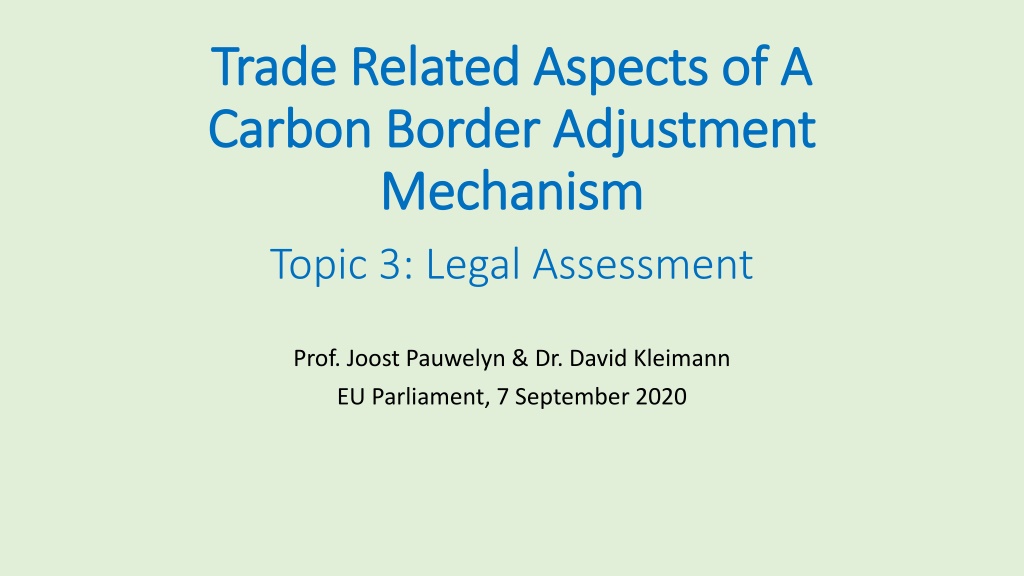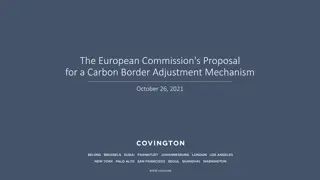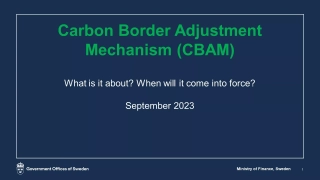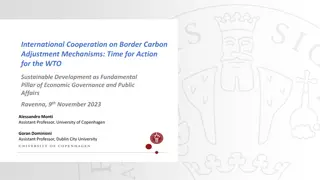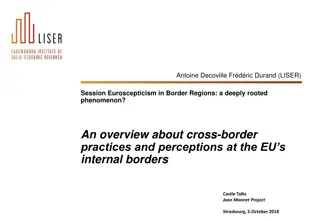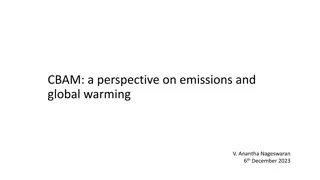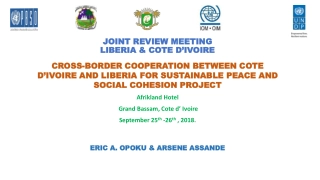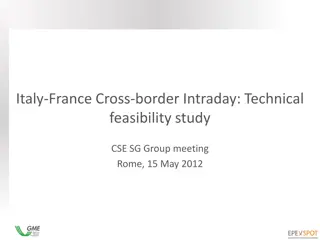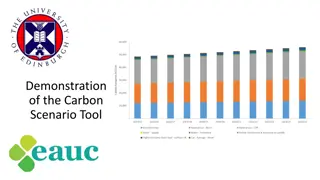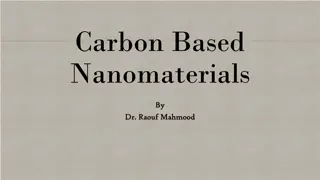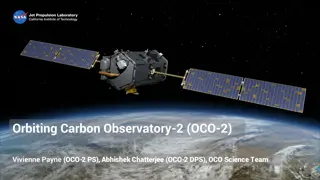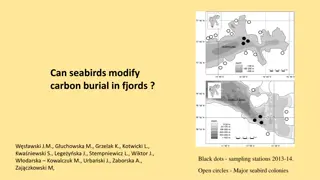Legal Assessment of a Carbon Border Adjustment Mechanism
This legal assessment explores the feasibility of implementing a Carbon Border Adjustment Mechanism under WTO agreements, focusing on topics such as adjustment on imports, rebates for exports, national treatment, non-discrimination, and environmental justifications. The analysis considers the potential implications of adjusting EU carbon measures on imports, examining aspects of discrimination, environmental grounds, and the necessity for climate goals.
- Legal Assessment
- Carbon Border Adjustment
- WTO Agreements
- Environmental Justification
- Non-Discrimination
Download Presentation

Please find below an Image/Link to download the presentation.
The content on the website is provided AS IS for your information and personal use only. It may not be sold, licensed, or shared on other websites without obtaining consent from the author. Download presentation by click this link. If you encounter any issues during the download, it is possible that the publisher has removed the file from their server.
E N D
Presentation Transcript
Trade Related Aspects of A Trade Related Aspects of A Carbon Border Adjustment Carbon Border Adjustment Mechanism Mechanism Topic 3: Legal Assessment Prof. Joost Pauwelyn & Dr. David Kleimann EU Parliament, 7 September 2020
A. Overview A. Overview - - Feasibility under WTO agreements Feasibility under WTO agreements * * Background on the nature and constraining power of WTO rules Overview of relevant WTO disciplines Adjustment on Imports Rebate for Exports Maximum tariff bindings - GATT Art. II Prohibition on export subsidies - SCM Art. 3 Prohibition on quantitative import restrictions - GATT Art. XI Export rebates permitted for indirect taxes - SCM ft. 1 & Annex I(g) National treatment - GATT Art. III MFN treatment - GATT Art. I Environmental exceptions - GATT Art. XX 1. Can EU carbon measure be adjusted also on imports? 2. If so: Is the import adjustment non-discriminatory ? 3. Even where violation: Is adjustment justified on environmental grounds? 4. Take away on WTO & Instrument-by-instrument conclusion
1. Can EU carbon measure be adjusted also on imports? TRADITIONAL (VAT) EU CARBON TAX EU EMISSIONS TRADING SYSTEM (ETS) Internal tax Indirect tax on products/inputs Is ETS tax or regulation? Is carbon tax / ETS sufficiently related to product/inputs ( indirect )? Free allowances or cost on imports? Environmental impact of rebating exports? How ensure level playing field between EU production and imports? Imposed also on imports Rebated for exports Level playing field (tax at destination principle)
2. Is the import adjustment non-discriminatory ? National Treatment Avoid country-based discrimination Avoid de facto discrimination between EU production and like imports Solution: Use EU group average with individual importer option to proof lower carbon footprint? Most-Favored Nation Treatment Adjust for carbon price already paid in country of production Exempt least developed countries Punitive tariffs on countries outside Paris Agreement
3. Even where violation: Is adjustment justified on environmental grounds ? Paragraph (b) or (g) Art. XX Health or conservation of exhaustible natural resources Sufficient nexus to EU territory Is adjustment related to / necessary for climate goal? Chapeau of Art. XX No discrimination between countries in same conditions Even if there is discrimination: is it justifiable or non-arbitrary? Avoid coercion on policy of other countries (e.g. punitive tariffs )
4. Take Away on WTO Stop using WTO concerns as scapegoat for inaction Border adjustment of internal EU carbon (fuel) tax would be easiest Also border adjustment of Emissions Trading System may be possible Key challenge: even-handed application of imports & across countries Even if violation: adjustment may be justified on environmental grounds Punitive tariffs on countries outside Paris Agreement most vulnerable to WTO challenge
B. Overview B. Overview Feasibility under EU Law Feasibility under EU Law Democratic and efficient decision-making Ordinary legislative procedure vs. special legislative procedure Qualified majority voting vs. unanimity Regulation vs. taxation Cross-cutting questions Is the Union competent to act? Is the Union competence exclusive or shared with the Member States? What is the legal basis for Union action? Which legislative procedure applies? Which legal acts are available for implementation?
1. Amending the EU ETS to include importers Shared competence for environment under 191(1) TFEU, 192(1)TFEU Note: CJEU considers that ETS constitutes a market-based measure and not a duty, tax, fee, or charge (C-366/101/EC - Air Transport Association of America and others) Does not trigger special legislative procedure and unanimity requirement under Article 192(2)(a)TFEU Ordinary Legislative Procedureto amend ETS Directive (EU Directive 2003/87/EC)
2. An EU carbon tax Shared competence for environment under 191(1) TFEU, 192(2)TFEU provisions primarily of a fiscal nature (Article 192(2)(a)) trigger special legislative procedure for adoption of tax directive Council decides unanimouslyon proposal by the Commission European Parliament NOT a co-legislator Passarelle Clause (Article 192(2)TFEU) allows for switch to OLP if Council decides to do so via unanimity Member State carbon tax possible if more stringent and compatible with EU Treaties
3. Punitive tariffs for imports from third countries that do not pursue policies in line with the Paris Agreement Dual legal basis: Article 207 TFEU (exclusive competence) and Article 191 TFEU (shared competence) Ordinary legislative procedure (Article 207(2) TFEU) to amend EU Enforcement Regulation (Regulation (EU) No 654/2014) Under the Enforcement Regulation , Commission adoptsimplementing acts via examination procedure (Article 5 of EU Regulation No. 182/2011) to impose duties on third countries
C. C. Take Away on WTO & EU law Take Away on WTO & EU law Carbon tax easiest to adjust at border (WTO) but procedural obstacles loom: #unanimity #EPinvolvement (EU) Cap-and-trade system may be adjustable at border with equivalent regulation on imports (WTO) and is easily adaptable to existing legislation: #OLP (EU) Punitive tariffs on countries outside Paris Agreement most vulnerable to WTO challenge and requires extensive amendments to existing Enforcement Regulation (EU)
